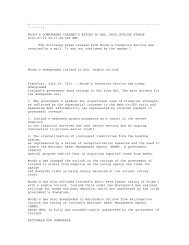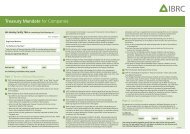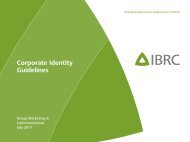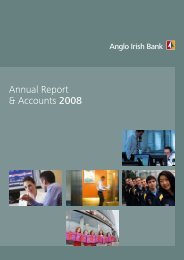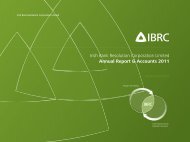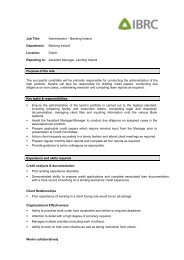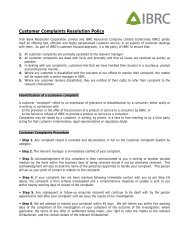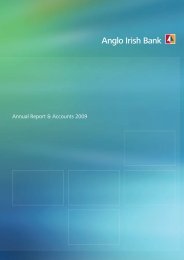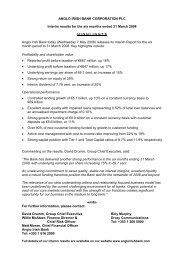IBRC annual report for 2011 - Irish Bank Resolution Corporation ...
IBRC annual report for 2011 - Irish Bank Resolution Corporation ...
IBRC annual report for 2011 - Irish Bank Resolution Corporation ...
Create successful ePaper yourself
Turn your PDF publications into a flip-book with our unique Google optimized e-Paper software.
<strong>Irish</strong> <strong>Bank</strong> <strong>Resolution</strong> <strong>Corporation</strong> LimitedAnnual Report & Accounts <strong>2011</strong>This provision is calculated by applying incurred loss factors to groups of loans sharing common risk characteristics. Loss factors aredetermined by historical loan loss experience as adjusted <strong>for</strong> current observable market data. Adjustments reflect the impact of currentconditions that did not affect the years on which the historical loss experience is based and remove the effects of conditions in thehistorical period that do not exist currently. The provision amount is also adjusted to reflect the appropriate loss emergence period. Theloss emergence period represents the time it takes following a specific loss event on an individual loan <strong>for</strong> that loan to be identified asimpaired. The loss emergence period applied in the period was six months (2010: six months).The future credit quality of loan portfolios against which an IBNR collective provision is applied is subject to uncertainties that couldcause actual credit losses to differ materially from <strong>report</strong>ed loan impairment provisions. These uncertainties include factors such as localand international economic conditions, borrower specific factors, industry trends, interest rates, unemployment levels and other externalfactors. For loan impairment details, see note 27.Assets classified as held <strong>for</strong> saleAssets that the <strong>Bank</strong> believes will be transferred to NAMA are classified as held <strong>for</strong> sale in the statement of financial position. The <strong>Bank</strong>has no control over the quantity of eligible assets that NAMA will acquire or over the valuation NAMA will place on those assets. At31 December <strong>2011</strong> NAMA had not confirmed to the <strong>Bank</strong> the final consideration it will pay in respect of assets transferred. Held <strong>for</strong> saleassets also include part of the <strong>Bank</strong>’s US loan book and certain other US assets expected to be sold to third parties. Loan and derivativeassets continue to be measured on the same basis as prior to their reclassification as held <strong>for</strong> sale. Other non-financial assets classified asheld <strong>for</strong> sale are stated at the lower of their carrying amount and fair value less costs to sell.Assets will continue to be carried in the statement of financial position until they legally transfer. The amount of consideration receivedwill be measured at fair value and any difference between the carrying value of the asset on the date of disposal and the considerationreceived less costs to sell will be recognised in the income statement.Carrying amount of investment propertyInvestment properties held at cost are reviewed regularly to determine their recoverable values and to assess impairment, if any. Where avalue in use calculation is per<strong>for</strong>med as part of this review, management estimates the future cash flows expected to be derived from theasset. Expectations of future cash flows, and any variations in their amount or timing, are subject to management judgement. In somecases, recoverable amount is based on management estimates.Fair valueFair value is the amount <strong>for</strong> which an asset could be exchanged, or a liability settled, between knowledgeable and willing parties in anarm's length transaction. Fair values are determined by reference to observable market prices where these are available and are reliable.Where representative market prices are not available or are unreliable, fair values are determined by using valuation techniques whichrefer to observable market data. These include prices obtained from independent third party pricing service providers, comparisons withsimilar financial instruments <strong>for</strong> which market observable prices exist, discounted cash flow analyses, option pricing models and othervaluation techniques commonly used by market participants. Where non-observable market data is used in valuations, any resultingdifference between the transaction price and the valuation is deferred on initial recognition. The deferred day one profit or loss is eitheramortised over the life of the transaction, deferred until the instrument’s fair value can be determined using market observable inputs orrealised through settlement, depending on the nature of the instrument and availability of market observable inputs. The accuracy of fairvalue calculations could be affected by unexpected market movements when compared to actual outcomes. Due to the increasingsignificance of credit related factors, determining the fair value of corporate interest rate derivative financial assets requires considerablejudgement. In the absence of unadjusted quoted market prices, valuation techniques take into consideration the credit quality of theunderlying loans when determining fair value. The most significant area of judgement is in relation to certain financial assets andliabilities classified as level 3 under the fair value hierarchy (note 51).As with all financial assets, NAMA senior bonds are measured at fair value at initial recognition. These bonds do not trade in an activemarket. Fair value at initial recognition has been estimated by using a valuation technique which takes into consideration theGovernment guarantee, collateral and other support, and the yield on <strong>Irish</strong> Government bonds of similar maturity. The bonds, which arevalued as short term instruments with a maturity date of 1 March 2012, are subsequently measured at amortised cost.TaxationThe taxation charge recognises amounts due to tax authorities in the various jurisdictions in which the Group operates. It includesestimates based on a judgement regarding the application of tax law and practice and the availability of future profits in order todetermine the quantification of current liabilities. In arriving at such estimates, management assesses the relative merits and risks of taxtreatments assumed, taking into account statutory, judicial and regulatory guidance and, where appropriate, external advice. Howeverthe final tax outcome may only be determined after the completion of tax audits or the expiration of statutes of limitations. In addition,changes in tax laws, judicial interpretation of tax laws, or policies and practices of tax authorities could cause the amount of taxesultimately paid to differ from the amount provided.Retirement benefitsThe Group operates defined benefit pension schemes. The Group’s two schemes have been closed to new members since January 1994.In determining the actual pension cost, the values of the assets and liabilities of the schemes are calculated. The assets of the schemesare valued at fair value. The liabilities of the schemes are measured on an actuarial basis, using the projected unit method anddiscounted at the current rate of return on a high quality corporate bond of equivalent term and currency to the liabilities. This involvesmodelling the future growth of scheme liabilities and requires management to make assumptions as to price inflation, dividend growth,salary and pensions increases, return on investments and employee mortality. There are acceptable ranges in which these estimates canreasonably fall. The impact on the Consolidated income statement and the Consolidated statement of financial position could bedifferent if an alternative set of assumptions was used. An analysis of the sensitivity of the liabilities of the schemes to changes in the keyassumptions is set out in note 11.55





